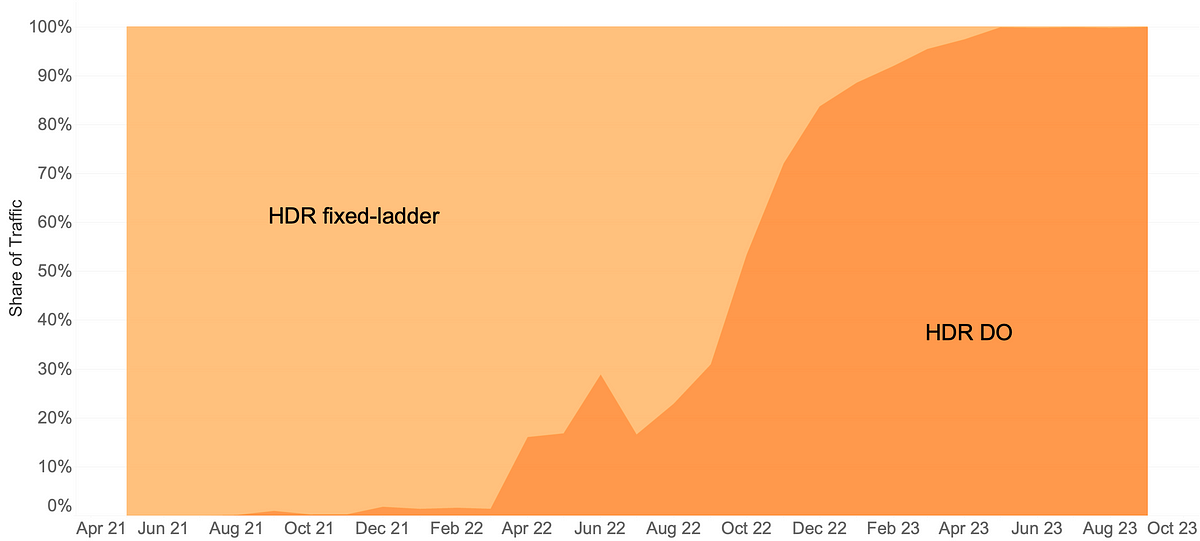It is very important notice that the fixed-ladder encodes had fixed period group-of-pictures (GoPs) and suffered from some inefficiency attributable to shot boundaries not aligning with Instantaneous Decoder Refresh (IDR) frames. The DO encodes are shot-based and so the IDR frames align with shot boundaries. For a given rate-quality working level, the DO course of helps allocate bits among the many numerous photographs whereas maximizing an general goal perform. Additionally because of the DO framework, inside a given rate-quality working level, difficult photographs can and do burst in bitrate as much as the codec stage restrict related to that time.
We A/B examined the mounted and optimized ladders; in the beginning to make it possible for units within the discipline can deal with the brand new streams and serving new streams doesn’t trigger unintended playback points. A/B testing additionally permits us to get a learn on the development in high quality of expertise (QoE). General, the enhancements could be summarized as:
- 40% fewer rebuffers
- Greater video high quality for each bandwidth-constrained in addition to unconstrained classes
- Decrease preliminary bitrate
- Greater preliminary high quality
- Decrease play delay
- Much less variation in delivered video high quality
- Decrease Web information utilization, particularly on mobiles and tablets
Sure, we’re dedicated to supporting the open-source neighborhood. The present implementation, nevertheless, is essentially tailor-made to our inner pipelines. We’re working to make sure it’s versatile, secure, and easy-to-use for the neighborhood. Moreover, the present model has some algorithmic limitations that we’re within the strategy of bettering earlier than the official launch. After we do launch it, HDR-VMAF could have larger accuracy in perceptual high quality prediction, and be simpler to make use of “out of the field”.
Because of the arrival of HDR-VMAF, we have been capable of optimize our HDR encodes. Mounted-ladder HDR encodes have been absolutely changed by optimized ones, decreasing storage footprint and Web information utilization — and most significantly, bettering the video high quality for our members. Enhancements have been seen throughout all machine classes starting from TVs to mobiles and tablets.
We thank all of the volunteers who participated within the subjective experiments. We additionally need to acknowledge the contributions of our colleagues from Dolby, particularly Anustup Kumar Choudhury, Scott Daly, Robin Atkins, Ludovic Malfait, and Suzanne Farrell, who helped with preparations and conducting of the subjective assessments.
We thank Matthew Donato, Adithya Prakash, Wealthy Gerber, Joe Drago, Benbuck Nason and Joseph McCormick for all of the fascinating discussions on HDR video.
We thank numerous inner groups at Netflix for the essential roles they play:
- The assorted shopper machine and UI engineering groups at Netflix that handle the Netflix expertise on numerous machine platforms
- The info science and engineering groups at Netflix that assist us run and analyze A/B assessments; we thank Chris Pham specifically for producing numerous information insights for the encoding workforce
- The Playback Programs workforce that steers the Netflix expertise for each shopper machine together with the expertise served in numerous encoding A/B assessments
- The Open Join workforce that manages Netflix’s personal content material supply community
- The Content material Infrastructure and Options workforce that manages the compute platform that permits us to execute video encoding at scale
- The Streaming Encoding Pipeline workforce that helps us orchestrate the technology of varied streaming property
Discover our work fascinating? Be a part of us and be part of the wonderful workforce that introduced you this tech-blog; open positions:
[1] L. Krasula, A. Choudhury, S. Daly, Z. Li, R. Atkins, L. Malfait, A. Mavlankar, “Subjective video high quality for 4K HDR-WCG content material utilizing a browser-based method for “at-home” testing,” Digital Imaging, vol. 35, pp. 263–1–8 (2023) [online]
[2] A. Choudhury, L. Krasula, S. Daly, Z. Li, R. Atkins, L. Malfait, “Testing 4K HDR-WCG skilled video content material for subjective high quality utilizing a distant testing method,” SMPTE Media Expertise Summit 2023




